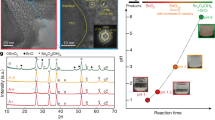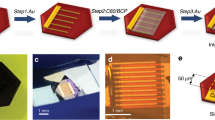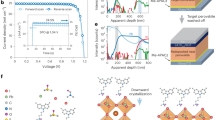Abstract
Many different photovoltaic technologies are being developed for large-scale solar energy conversion1,2,3,4. The wafer-based first-generation photovoltaic devices1 have been followed by thin-film solid semiconductor absorber layers sandwiched between two charge-selective contacts3 and nanostructured (or mesostructured) solar cells that rely on a distributed heterojunction to generate charge and to transport positive and negative charges in spatially separated phases4,5,6. Although many materials have been used in nanostructured devices, the goal of attaining high-efficiency thin-film solar cells in such a way has yet to be achieved7. Organometal halide perovskites have recently emerged as a promising material for high-efficiency nanostructured devices8,9,10,11. Here we show that nanostructuring is not necessary to achieve high efficiencies with this material: a simple planar heterojunction solar cell incorporating vapour-deposited perovskite as the absorbing layer can have solar-to-electrical power conversion efficiencies of over 15 per cent (as measured under simulated full sunlight). This demonstrates that perovskite absorbers can function at the highest efficiencies in simplified device architectures, without the need for complex nanostructures.
This is a preview of subscription content, access via your institution
Access options
Subscribe to this journal
Receive 51 print issues and online access
$199.00 per year
only $3.90 per issue
Buy this article
- Purchase on Springer Link
- Instant access to full article PDF
Prices may be subject to local taxes which are calculated during checkout



Similar content being viewed by others
References
Green, M. A. Silicon photovoltaic modules: a brief history of the first 50 years. Prog. Photovolt. Res. Appl. 13, 447–455 (2005)
Graetzel, M., Janssen, R. A. J., Mitzi, D. B. & Sargent, E. H. Materials interface engineering for solution-processed photovoltaics. Nature 488, 304–312 (2012)
Chopra, K. L., Paulson, P. D. & Dutta, V. Thin-film solar cells: an overview. Prog. Photovolt. Res. Appl. 12, 69–92 (2004)
O’Regan, B. & Grätzel, M. A low-cost, high-efficiency solar cell based on dye-sensitized colloidal TiO2 films. Nature 353, 737–740 (1991)
Halls, J. J. M. et al. Efficient photodiodes from interpenetrating polymer networks. Nature 376, 498–500 (1995)
Yu, G., Gao, J., Hummelen, J. C., Wudl, F. & Heeger, A. J. Polymer photovoltaic cells: enhanced efficiencies via a network of internal donor-acceptor heterojunctions. Science 270, 1789–1791 (1995)
Green, M. A., Emery, K., Hishikawa, Y., Warta, W. & Dunlop, E. D. Solar cell efficiency tables (version 40). Prog. Photovolt. Res. Appl. 20, 606–614 (2012)
Lee, M. M., Teuscher, J., Miyasaka, T., Murakami, T. N. & Snaith, H. J. Efficient hybrid solar cells based on meso-superstructured organometal halide perovskites. Science 338, 643–647 (2012)
Kojima, A., Teshima, K., Shirai, Y. & Miyasaka, T. Organometal halide perovskites as visible-light sensitizers for photovoltaic cells. J. Am. Chem. Soc. 131, 6050–6051 (2009)
Kim, H.-S. et al. Lead iodide perovskite sensitized all-solid-state submicron thin film mesoscopic solar cell with efficiency exceeding 9%. Sci. Rep. 2 591 10.1038/srep00591 (2012)
Noh, J. H., Im, S. H., Heo, J. H., Mandal, T. N. & Il Seok, S. Chemical management for colorful, efficient, and stable inorganic-organic hybrid nanostructured solar cells. Nano Lett. 13, 1764–1769 (2013)
Huynh, W. U., Dittmer, J. J. & Alivisatos, A. P. Hybrid nanorod-polymer solar cells. Science 295, 2425–2427 (2002)
Arici, E., Sariciftci, N. S. & Meissner, D. Hybrid solar cells based on nanoparticles of CuInS2 in organic matrices. Adv. Funct. Mater. 13, 165–171 (2003)
McDonald, S. A. et al. Solution-processed PbS quantum dot infrared photodetectors and photovoltaics. Nature Mater. 4, 138–142 (2005)
Cheng, Z. & Lin, J. Layered organic–inorganic hybrid perovskites: structure, optical properties, film preparation, patterning and templating engineering. CrystEngComm 12, 2646–2662 (2010)
Heo, J. H. et al. Efficient inorganic-organic hybrid heterojunction solar cells containing perovskite compound and polymeric hole conductors. Nature Photon. 7, 486–491 (2013)
Ball, J. M., Lee, M. M., Hey, A. & Snaith, H. J. Low-temperature processed meso-superstructured to thin-film perovskite solar cells. Energy Environ. Sci. 6, 1739–1743 (2013)
Mosconi, E., Amat, A., Nazeeruddin, M. K., Grätzel, M. & De Angelis, F. First principles modeling of mixed halide organometal perovskites for photovoltaic applications. J. Phys. Chem. C 117, 13902–13913 (2013)
Snaith, H. J., Greenham, N. C. & Friend, R. H. The origin of collected charge and open-circuit voltage in blended polyfluorene photovoltaic devices. Adv. Mater. 16, 1640–1645 (2004)
Yang, F., Shtein, M. & Forrest, S. R. Morphology control and material mixing by high-temperature organic vapor-phase deposition and its application to thin-film solar cells. J. Appl. Phys. 98, 014906 (2005)
Sakata, H. et al. in Photovoltaic Specialists Conf. (Conference Record of the Twenty-Eighth IEEE) 7–12 10.1109/PVSC.2000.915742 (2000)
Reineke, S. et al. White organic light-emitting diodes with fluorescent tube efficiency. Nature 459, 234–238 (2009)
You, H., Dai, Y., Zhang, Z. & Ma, D. Improved performances of organic light-emitting diodes with metal oxide as anode buffer. J. Appl. Phys. 101, 026105 (2007)
Riede, M. et al. Efficient organic tandem solar cells based on small molecules. Adv. Funct. Mater. 21, 3019–3028 (2011)
Beiley, Z. M. & McGehee, M. D. Modeling low cost hybrid tandem photovoltaics with the potential for efficiencies exceeding 20%. Energy Environ. Sci. 5, 9173–9179 (2012)
Acknowledgements
This work was funded by EPSRC and the European Research Council (ERC) ‘Hyper Project’ number 279881. The Oxford University Press (John Fell) Fund provided support for equipment used in this study, specifically the organic light-emitting diode vapour-deposition equipment. We thank S. Sun, E. Crossland, P. Docampo, G. Eperon, J. Zhang and J. Liu for discussions and experimental and technical assistance.
Author information
Authors and Affiliations
Contributions
M.L. performed the experimental work, data analysis and experimental planning. The project was conceived, planned and supervised by H.S. and M.J. The manuscript was written by all three authors.
Corresponding author
Ethics declarations
Competing interests
The authors declare no competing financial interests.
Extended data figures and tables
Extended Data Figure 1 Top-view SEM images for the vapour-deposited perovskite films.
a, As-deposited perovskite film; b, post-annealed perovskite film.
Source data
Rights and permissions
About this article
Cite this article
Liu, M., Johnston, M. & Snaith, H. Efficient planar heterojunction perovskite solar cells by vapour deposition. Nature 501, 395–398 (2013). https://doi.org/10.1038/nature12509
Received:
Accepted:
Published:
Issue Date:
DOI: https://doi.org/10.1038/nature12509
This article is cited by
-
How to improve the structural stabilities of halide perovskite quantum dots: review of various strategies to enhance the structural stabilities of halide perovskite quantum dots
Nano Convergence (2024)
-
Numerical simulation based performance enhancement approach for an inorganic BaZrS3/CuO heterojunction solar cell
Scientific Reports (2024)
-
High brightness and low operating voltage CsPbBr3 perovskite LEDs by single-source vapor deposition
Scientific Reports (2024)
-
Crystal growth, Hirshfeld analysis, thermal behavior and magnetic properties of a new hybrid material (C5H14N2)[MnCl3(H2O)3]Cl
Journal of the Iranian Chemical Society (2024)
-
Thermal engineering control of inorganic perovskite CsPbIBr2 film and optimization of photoelectric performance
Journal of Nanoparticle Research (2024)
Comments
By submitting a comment you agree to abide by our Terms and Community Guidelines. If you find something abusive or that does not comply with our terms or guidelines please flag it as inappropriate.



